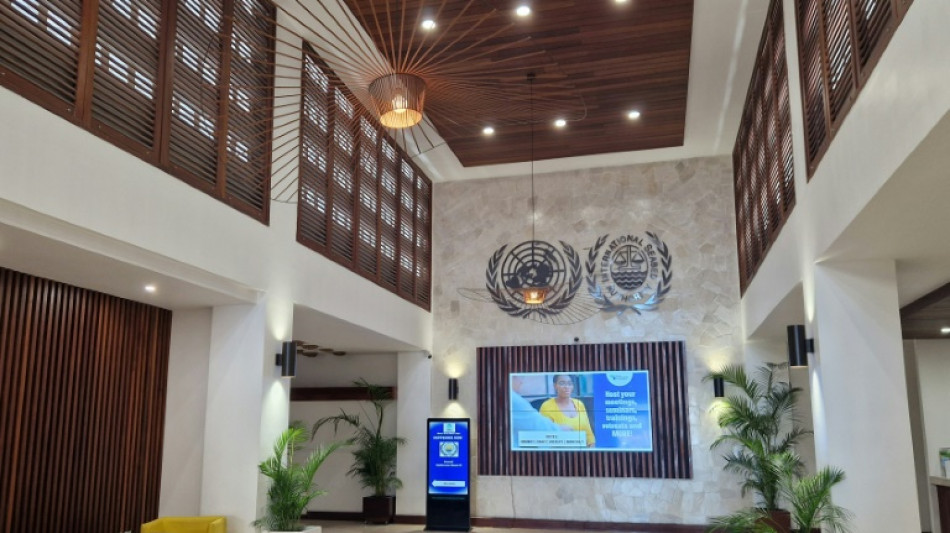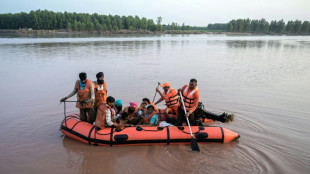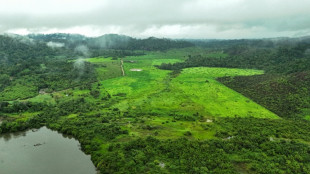
-
 E. Timor police clash with protesters over plan to buy vehicles for MPs
E. Timor police clash with protesters over plan to buy vehicles for MPs
-
Israel launches ground assault on Gaza City

-
 Malawi votes in battle of two presidents as economic crisis bites
Malawi votes in battle of two presidents as economic crisis bites
-
2025 summer was Spain's warmest on record: weather agency

-
 Gout of this world? Australian teen sprinter set for first real test
Gout of this world? Australian teen sprinter set for first real test
-
Smoke-dried bodies could be world's 'oldest mummies': study

-
 Afghan gets life in prison for jihadist knife murder in Germany
Afghan gets life in prison for jihadist knife murder in Germany
-
Trump bringing $15 bn lawsuit against New York Times

-
 Juan Mata moves to Melbourne from Australian rivals
Juan Mata moves to Melbourne from Australian rivals
-
UN investigators say Israel committing 'genocide' in Gaza

-
 Rubio asks Qatar to stay as mediator after Israel strike
Rubio asks Qatar to stay as mediator after Israel strike
-
Drug cheats put India Olympic bid and careers at risk

-
 East Timor police fire tear gas on second day of car purchase protests
East Timor police fire tear gas on second day of car purchase protests
-
Austria hit with fresh spy claims after govt promises law change

-
 Floods devastate India's breadbasket of Punjab
Floods devastate India's breadbasket of Punjab
-
In mega-city Lagos, 20 million count on just 100 ambulances

-
 FBI chief Kash Patel faces Senate panel
FBI chief Kash Patel faces Senate panel
-
Trump says bringing $15 bn lawsuit against New York Times

-
 Israel sets Gaza 'on fire' as Rubio warns days left for deal
Israel sets Gaza 'on fire' as Rubio warns days left for deal
-
Phillies clinch first MLB division by beating Dodgers

-
 'Nothing here': Lack of jobs forces young Nepalis abroad
'Nothing here': Lack of jobs forces young Nepalis abroad
-
Rubio asks Qatar to stay as mediator after Israeli strike

-
 Trump set for unprecedented second UK state visit
Trump set for unprecedented second UK state visit
-
Lower US tariffs on Japan autos kick in

-
 Revamped Bayern face early test as Chelsea come to town
Revamped Bayern face early test as Chelsea come to town
-
Papua New Guinea, Australia to vow mutual defence in new treaty

-
 Malawi election a battle of two presidents
Malawi election a battle of two presidents
-
Asian markets rise as traders prepare for expected US rate cut

-
 Malawi votes in a rematch between two presidents as economic crisis bites
Malawi votes in a rematch between two presidents as economic crisis bites
-
Australia says social media ban will not age test all users

-
 Poland's Nawrocki talks drone defence in Paris and Berlin
Poland's Nawrocki talks drone defence in Paris and Berlin
-
Trump's fossil fuel agenda challenged in youth climate suit

-
 PSG fear impact of injuries as they put Champions League title on the line
PSG fear impact of injuries as they put Champions League title on the line
-
Papua New Guinea, Australia will commit to mutual defence

-
 Trash, mulch and security: All jobs for troops in Washington
Trash, mulch and security: All jobs for troops in Washington
-
NFL legend Brady to play in March flag football event at Riyadh

-
 Lower US tariffs on Japan autos to take effect Tuesday
Lower US tariffs on Japan autos to take effect Tuesday
-
US strikes second alleged Venezuelan drug boat as tensions mount

-
 Protesting Peru residents block trains to Machu Picchu
Protesting Peru residents block trains to Machu Picchu
-
US strikes another alleged Venezuelan drug boat as tensions rise

-
 White House vows to take on left-wing 'terror' movement after Kirk killing
White House vows to take on left-wing 'terror' movement after Kirk killing
-
Brazil's Amazon lost area the size of Spain in 40 years: study

-
 US Senate poised to advance Trump aide's appointment at Fed
US Senate poised to advance Trump aide's appointment at Fed
-
Sri Lanka survive Hong Kong scare for four wicket Asia Cup win

-
 Mbappe 'not anxious' over Champions League goal as Bellingham returns
Mbappe 'not anxious' over Champions League goal as Bellingham returns
-
Huge pot of Nigerian jollof rice sets Guinness record

-
 Heartbreak will help Arsenal's Champions League charge: Arteta
Heartbreak will help Arsenal's Champions League charge: Arteta
-
Europe stumped by Trump demands over Russia sanctions

-
 Cycling fears spread of race-halting protests after Vuelta chaos
Cycling fears spread of race-halting protests after Vuelta chaos
-
'With our fists if necessary': Venezuelans prepare to defend homeland against potential US invasion


Restoring sea floor after mining may not be possible, researchers warn
Scientists present at the latest effort to hash out international rules for deep-sea mining say it's unclear if it's possible to restore damaged sea floor ecosystems -- or how long it would take.
One of the last wild zones on the planet, the sea floor is a coveted frontier for companies and countries eager to access minerals that are in high demand for emerging technologies such as electric cars.
Particularly coveted are potato-sized nodules containing cobalt, nickel, copper and manganese, that are found in abundance on the seabed in the central Pacific Ocean.
Companies eager to vacuum up these polymetallic nodules say they can do it with minimal risk to the deep-sea environment.
But ocean defenders have battled against what they see as the advent of an industry that will threaten isolated ecosystems that are not yet well understood.
That threat was underscored by European scientists who presented findings this week on the sidelines of a meeting in Kingston, Jamaica of the International Seabed Authority, which is trying to finalize future rules for seabed mining.
"If we remove nodules from the seabed, we do not know what we lose, only that it's lost forever," was one of the conclusions of DEEP REST, a sea floor conservation research project.
The DEEP REST study cautioned against using seabed restoration "as a management action for impacted habitats."
"So far, all the restoration operations we have attempted within our DEEP REST project have been short-term. And what we observed, is that in the given time, that is to say a few years, the ecosystems do not recover," said Jozee Sarrazin, a researcher at the French Institute for Ocean Science, or Ifremer.
"If restoration is possible, it will take a very long time, and at the moment we don't have the data to be able to say if that will be 100 years or 1000 years," the DEEP REST coordinator told AFP.
Despite the pressure, the cold, the total darkness, and the lack of nutrition sources at the bottom of the ocean, it is teeming with life.
The number of species who live on the deep seabed is not yet known but estimated to be in the millions.
- Soft corals, sea anemone -
Broad swathes of the Pacific Ocean where polymetallic nodules are found shelter fauna such as sponges, soft corals or sea anemones.
The fauna "only exists in these areas because they need the hard substrate of the nodule to attach," said Matthias Haeckel of the German research center GEOMAR, which presented results of the MiningImpact project in Kingston this week.
Vacuuming up these nodules and spreading sediment over the impacted areas reduces population densities, biodiversity and the functioning of ecosystems, MiningImpact's study found.
"To make the story short, in the end, we're talking about recovery times of thousands of years," Haeckel said. The nodules themselves form over millions of years.
Some research on restoration efforts is underway but the results are not yet in.
"We designed artificial nodules made of deep-sea clay and we placed them at different sites" at depths of about 4,500 meters (14,700 feet), Sabine Gollner, a biologist at the Royal Netherlands Institute for Sea Research, told AFP.
"But when you take into account the slow growth rates in the deep sea, the slow processes, it will take quite some more years to find out if restoration is effective and to what degree," she said.
Massive deposits of sulfide -- a type of mineral deposit found in underwater vents that spit out seawater heated by magma -- should be off-limits, the researchers suggest.
These types of underwater geysers are teeming with astonishing and unique biodiversity.
"If we extract massive sulfides near active vents, we know what we lose, and we must prevent loss," the DEEP REST study says.
But according to Gollner, it would be good to incorporate restoration goals into the mining code being negotiated by the International Seabed Authority's member states.
"It's good to include it but with a clear statement that at this moment in time, it cannot be taken into account to reach agreed environmental goals," she said.
"For example, a contractor shouldn't be allowed to use that argument to mine a larger area."
S.Leonhard--VB
